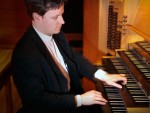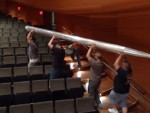Title
Paul Jacobs will rededicate the magnificent Alice Tully Hall pipe organ. (Photo by Nicole Szalewski) Alice Tully Hall will once again resound to the music of its magnificent pipe organ in three November concerts. On November 16, the newly renovated organ will be rededicated by Paul Jacobs, chair of Juilliard’s organ department. His recital, part of the new annual White Light Festival at Lincoln Center, will feature the Clavier-Übung (Part III) by J.S. Bach, a masterpiece rarely heard in its entirety.
Body
The following day, the students of Juilliard’s organ department perform works from the 19th century to the present on the Wednesdays at One series. And on November 22, Michael Hey, the winner of the Juilliard organ concerto competition, will play Handel’s Concerto in G Minor, Op. 4, No. 1, with the Juilliard Orchestra, conducted by Nicholas McGegan.
With 4,192 pipes, playable from four keyboards and pedal, the Tully organ weighs in at an impressive 19 tons, and is capable of sounds from a whisper to a roar. Built and installed in 1974 by Orgelbrau Th. Kuhn of Männedorf, Switzerland, it can be used both for the entire range of solo organ literature, for continuo accompaniment in Baroque music, and as a solo instrument with orchestra.
For his recital, Jacobs has taken up an unfairly neglected work of J.S. Bach. In his four-volume Clavier-Übung, which means “keyboard practice,” Bach set out to create a complete encyclopedia of keyboard music as it was then known. Among the famous pieces contained in it are the “Italian” Concerto and the “Goldberg” Variations. The third volume, devoted exclusively to organ music, is described by the Bach scholar and Juilliard faculty member Christoph Wolff as “Bach’s most significant work for the organ.” Jacobs agrees, adding that “the scope and design of this creation are truly awe-inspiring.”
The bulk of the collection is based on chorales, or Lutheran hymn tunes. The preludes mostly come in pairs—a large and a small setting for each tune, often strikingly different. Many of these tunes are no longer familiar to audiences, especially in this country, which presents a challenge to the performer looking to convey the musical and theological subtleties of Bach’s music. In his recital, Jacobs will collaborate with the Clarion Choir, directed by Steven Fox, one of New York’s most exciting young conductors. The choir will sing each chorale before Jacobs plays the organ settings, giving the audience a chance to savor the relationship between the original tunes and Bach’s elaborations.
Jacobs, who performed an 18-hour marathon of Bach’s complete organ works in 2000, is a strong advocate for this music. “I’m frequently surprised,” he says, “to learn what little acquaintance many fine musicians have with Bach’s major organ works. Hopefully this performance will provide an opportunity to deepen the understanding and fervor we have for Bach.”
On November 17 the Kuhn organ’s versatility will be on display at the Juilliard organ department’s performance, which will explore organ repertoire from the 19th century to the present day. Although the Tully Hall organ takes a good deal of inspiration from Baroque instruments, it is designed for great flexibility in playing Romantic and contemporary music.
The Juilliard Orchestra concert on November 22 offers yet another perspective on the instrument. Handel wrote two wildly popular sets of organ concertos, which he played himself between acts of his oratorios. In complete contrast to the meticulously notated scores of his great contemporary, Bach, Handel left only a sketch in certain places of the solo part, leaving the performer to fill in the details. The G-minor Concerto belongs to the secular world, not the sacred. It is wonderfully tuneful from beginning to end.
The organ in Alice Tully Hall was a personal gift of Miss Tully, who wanted to ensure that the concert hall named for her possessed a first-class organ. At its inauguration, the organ was played by such notable musicians as André Marchal, Karl Richter, and E. Power Biggs, and received rave reviews. Allen Hughes, then a critic for The New York Times, wrote that Richter’s performance “dazzled the ear with color and brilliance.”

Workers carry one of the 4,192 pipes that make up the 19-ton organ. (Photo by Mark Bussell)In 2006, during preparations for the extensive renovations of Tully Hall, the organ was removed and put in storage outside Albany. There it stayed until May 2010, when it was cleaned and restored by technicians from Kuhn. In June, it was returned to Lincoln Center, and, pipe by pipe, its components reassembled.
However, with the new acoustical environment in the hall, some adjustment was necessary. A pipe organ is custom-built for the room it will occupy, and voiced on-site for greatest effectiveness. When, as sometimes happens, pipe organs are moved from one building to another, they must be revoiced for the new space. This work was completed in October, and the organ is now ready for its debut. Jacobs says that the improvements should make the instrument “more attractive to both performer and listener.”
With the renovation project completed, Alice Tully Hall will be the only major concert hall in New York with a pipe organ. Jacobs is excited by the possibilities. “There is a treasure trove of organ music, old and new, just waiting to be discovered by Lincoln Center audiences,” he says. “Now that Miss Tully’s organ is back, the field is ripe for harvesting.”
Facts About the Alice Tully Hall Organ

Workers unload the organ upon its return to Lincoln Center on June 14. It was stored outside Albany, N.Y., for four years during the renovation of Alice Tully Hall. (Photo by Chris Downes)
The organ was a personal gift from Miss Alice Tully to the hall that bears her name. It was designed and constructed to be not only a virtuoso solo instrument but one capable of blending with a chamber ensemble or full orchestra. Space for the organ was part of the original plan for the hall.
The organ ...
- Was built in 1974.
- Was designed and constructed by Orgelbrau Th. Kuhn of Männedorf, Switzerland.
- Weighs 19 tons.
- Has 4,192 pipes with 85 ranks distributed in 61 speaking stops.
- Its longest pipe is 18.3-feet long; the shortest pipe is one-10th of an inch.
- Some of the pipes are made of wood; the majority are metal.
- Has direct mechanical linkage from keys to pipes.
- Was inaugurated with a concert in Alice Tully Hall on April 13, 1975, by E. Power Biggs, who proclaimed: “The Tully Hall instrument is built the way God intended organs to be built!”
- Was removed from the hall in 2006 in anticipation of its renovation. The organ was put into storage in a facility outside Albany, N.Y., during which time it was cleaned and polished by hand and the pipes were individually ‘trued’ to their original round shape. Also, the console was cleaned, rewired, and rejointed, and the wood was restained and revarnished.
- Was returned to Alice Tully Hall in June 2010 for reinstallation.






